Back in January last year, Helen Brown, Lecturer in Health, Safety and Environment at Curtin University, published an article in The Conversation arguing that the lack of trees in new housing developments is significantly increasing the use of air conditioners and energy use:
Air conditioners across the country are running on full this week as Australia battles a heatwave – but are we missing an obvious, leafy solution?
Trees, which provide shade and act as natural air conditioners, play an important role in helping to create cities that are more resilient to extreme temperatures as the climate warms. In urban areas, however, trees are under considerable pressure.
With last year’s record hot weather, and projections for more frequent and severe heatwaves, this week’s weather may be a sign of things to come.
So why are all the trees removed in so many of our developments?
The population of major Australian cities is expected to double in the next four to five decades. Planned increases in urban density are likely to result in the removal of a significant number of trees from urban areas.
Fewer trees in cities help create urban heat island effects – that’s when buildings and footpaths absorb the sun’s heat and then radiate it back out. Increases of up to three degrees are common and, in extreme cases, night-time increases of up to 12 degrees have been recorded.
Ms Brown was joined by a group of Melbourne and Monash University academics, who produced similar analysis arguing that the loss of vegetation from urban consolidation is causing heat-island effects, in turn raising temperatures and energy use:
Urban vegetation has an important role in easing these temperatures, which means that a city’s public parks, remnant woodlands, residential gardens, nature strips, street trees, green roofs, green walls and rain gardens are all vital for maintaining its liveability.
As such, this greenery – collectively termed “urban green infrastructure” – confers a wealth of environmental, economic and health benefits to city residents. By actively cooling the urban landscape, it helps reduce energy use and carbon dioxide emissions, and ultimately lessens the risk of residents suffering heat stress, heatstroke or even death…
Ever-growing houses, on ever-shrinking plots, mean that the average backyard has shrunk. Population growth has driven up property prices so that residential blocks are being subdivided for units or townhouses.
Meanwhile, larger green open spaces are being sold and developed…
As one of the most urbanised countries in the world, Australia could benefit greatly from increasing the extent and quality of its urban green infrastructure. Doing so has repeatedly been shown to reduce the “urban heat island” effect – a critical issue considering climate change predictions foretelling more intense and more frequent heatwaves.
Thermal mapping observations collected in Melbourne suggest that on average, a 10% increase in urban green cover could reduce the daytime surface temperature during heatwaves in our cities by around 1°C. However, US research has shown that for a similar reduction in urban air temperatures, a much larger increase in greenery is required.
With these issues in mind, it is interesting to read that Acting Cities Minister, Greg Hunt, will today outline a plan to tackle the “heat island effect” by setting goals for each decade to 2050 to increase “urban canopies”, or overall tree coverage. From The Canberra Times:
In a speech to the Sydney Business Chamber on Tuesday, his first since assuming the role, Mr Hunt is expected to emphasise the susceptibility to extreme heat of people living in large cities.
Urban development pressures can lead to treeless streets that amplify the “heat island” effect on hot days…
“Extreme heat place[s] the most vulnerable people in our cities – including the very young and very old – at high risk, and contributes to a number of deaths each year,” his speech notes say.
As well as decade-by-decade goals to develop urban canopies, the government will “look at building rooftops with green cover”…
While Hunt’s ambition is admirable, one wonders how so-called “urban green infrastructure” can be increased amid never-ending immigration and population growth and the corresponding increased urban density, which is seeing backyards and green space disappear in order to accommodate new housing and infrastructure?
It is worth noting that housing developments built in the 1950s, 1960s, 1970s, 1980s and 1990s (represented below on the right) typically have large blocks, ample green space, and lots of tree cover. In short, they are a desirable places to live and do not suffer from the “heat island effect”. Now compare these 20 to 60 year-old developments with the cluttered rubbish produced today (represented below on the left), which are proliferating thanks to endless population growth and urban consolidation.

Maybe I am missing something here, but it would seem that increasing “urban green infrastructure” each decade to 2050 in places like Melbourne is not consistent with the projected explosion of the city’s population to 8 million, along with the increased population density?

